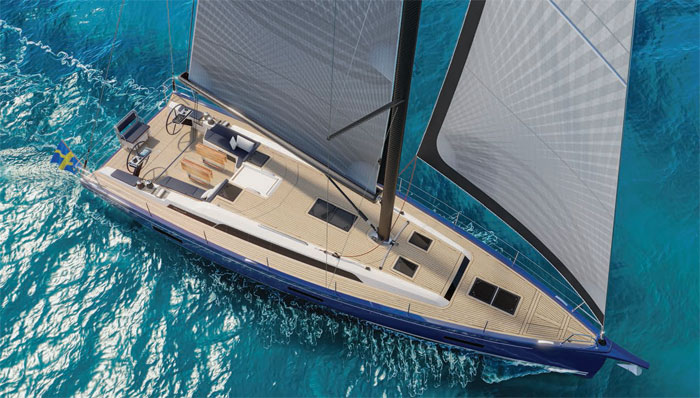

The Swedish Arcona yard invested heavily in design and development and have been fastidious in the execution to ensure that they enter the busy 50-footer market right at the very top
When she launches this spring, the new Arcona 50 will be the perfect flagship for the Swedish builder. The company’s quiet confidence stems from their approach to the design and build of a range of high quality, good looking cruisers that deliver far more performance than the modern yet modest looks suggest. Their style of production also sits well with the location of their yard which itself has a long-held reputation for producing some of the world’s strongest and most respected brands. But make no mistake, confident they may be, but the 50 is still a big deal for Arcona Yachts.
The 50ft market has become extremely competitive thanks in part to the ease with which large boats can be handled shorthanded with sophisticated modern hardware and systems. The scaling effect also plays a part in providing more volume to create ever more elaborate and enticing interiors. The same is true with exterior styling where boats of this size have a natural advantage and can adopt and reflect modern trends in performance hull shapes with ease.
But size alone doesn’t necessarily make these features desirable.
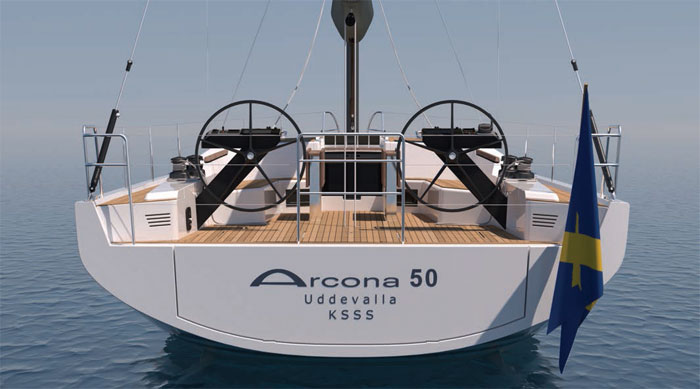
This twin wheel setup looks conventional but is actually quite unusual, incorporating two independent systems
Arcona Yachts are as keen as the next yard to take full advantage of the benefits that modern design and technology may offer, but the company is also completely focussed on ensuring that its new models don’t stray from the characteristics that have built their strong reputation for understated performance cruisers. To this end it is frequently the aspects that don’t stand out at first glance that have helped to create and sustain the cult following among Arcona enthusiasts. And in that sense, the new 50 is expected to be a perfect fit.
Her hull shape gives the first clues. She has a plumb bow, beamy sections aft and chines, but they’re soft chines, well radiused and modest. Their position and proportions are set to match the distribution of buoyancy forwards which in turn ensures that the 50 is well balanced on the helm, especially when heeled. Additional volume both fore and aft has provided a more spacious owner’s cabin forward as well as a spacious dinghy garage accessed via the opening transom.
The option for a fixed carbon bowsprit is another example of a detail that has been carefully thought through. The benefits need little explanation when it comes to the ease of flying asymmetric spinnakers and furling code sails, as well as the convenience when it comes to anchoring. But this is an option that weighs the same as the standard and conventional stainless steel anchor roller unit. Continuing the theme, the option for a carbon mast and boom along with a variety of sheeting arrangements for the main and jib may look like features that simply emulate modern performance boat trends, but the thinking behind each of them has been considerable.
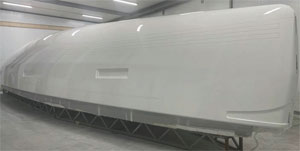
‘We’ve stopped talking about the navigation station and tend to refer to this area as the workstation,’ says designer Niels Jeppesen. ‘The Arcona 50 will be a highly versatile boat, but the common denominator and biggest fundamental factor is weight.’
But why? This is not a boat that will line up against an all-carbon TP52.
‘Performance is every bit as important to the cruising sailor as it is to the most competitive crews on the circuit. And if it isn’t, it should be,’ he says. ‘Making sure the weight is where it should be is essential in achieving a boat that is easy to manage, whether you’re sailing shorthanded or fully crewed. Most people will understand that in a strong breeze you want the centre of gravity to be low and that a heavy bulb helps to achieve this.
‘Saving weight aloft achieves the biggest gains, the options for a carbon mast and boom are there for this reason. Saving small amounts of weight high up has big benefits when it comes to adding weight in the keel.
‘We have spent a great deal of time looking closely at the sail plan options which focus primarily on conventional slab reefing or in-boom furling. They are further examples of how we are striving to keep the centre of gravity low and get the best handling as well as the best performance. We have also looked very carefully at the operation of the systems and the control line layouts. Achieving a range of gears is one thing but making sure you can switch between them easily is just as important. The link between a stiffer boat and saving weight in the accommodation is less well understood, but this is still weight that we can put in the keel.’
When building a high-quality blue water cruiser there will always be a balance to be struck between creating an elegant, practical and robust interior and saving weight, something Arcona Yachts’ CEO Urban Lagnéus is acutely aware of.
‘As we went through the design process and took a close look at weight it was clear that saving say 25kg was often possible’, he says. ‘On the other hand, when considered in isolation it is also clear that a weight saving of this size is tiny, almost insignificant on a 50ft boat. So, the next task was to look at how many times 25kg could be saved. Achieve it 10 times and the picture starts to look very different.’
But even then, the weight saving issue is still not straightforward.
‘There’s something about getting to 50ft that makes people want to put all kinds of items aboard their boats,’ Jeppesen continues. ‘Given the nature of their long-distance cruising it is completely understandable. Even so, the fact remains that below this size, say in a 35-footer people know that they will always be making compromises. Yet the bigger you go, the less they keep this concept in mind. So, part of the design process was keeping the weight obsession in mind while accepting that people would want to be adding dishwashers, washing machines, bicycles and so on. So, it was our job to anticipate this and look for the most weight-efficient items without compromising on quality.’
While weight was uppermost in their minds, Jeppesen along with the boat’s naval architect and designer Ariadna Pons and the Arcona Yachts team were also on a mission to make the 50 an easy boat to sail well.
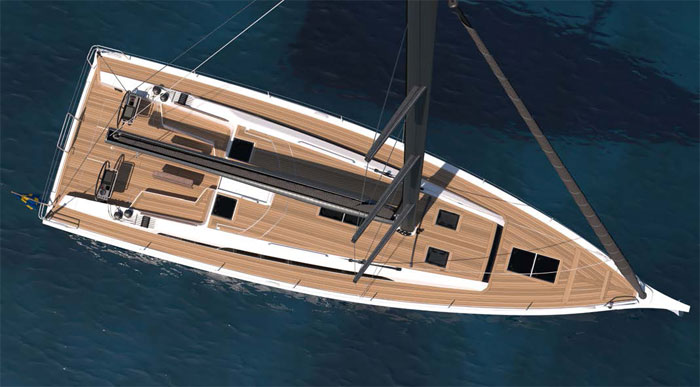
Choosing the option for carbon spars is the most effective way to boost the boat’s performance, increasing its righting moment and reducing pitching and rolling in rough seas
‘The fixed carbon bowsprit is a good option for an asymmetric spinnaker but for those looking to sail shorthanded a code zero is a far better option in my opinion,’ says Jeppesen. ‘You can sail very deep with one, you can use it upwind in light airs and can raise or lower it easily from the deck. I’m not sure that I’d have an asymmetric kite.’
The option for a self-tacking jib is another detail that will appeal to those sailing shorthanded, but the ability to combine this with longitudinal tracks on the coachroof allows additional versatility elsewhere in the sail plan. From setting an overlapping jib and sheeting to the tracks, through to a self-tacking heavy weather jib attached to the inner forestay, the geometry of the foretriangle and the deck layout has been carefully worked out to allow as many options as possible while keeping things simple too.
Further aft, the cockpit has an option for a mainsheet traveller. The standard setup is a simple mainsheet attachment on the cockpit sole, but even then the attachment is concealed to give a neat, flush look.
Below the waterline the Arcona 50 has twin rudders, as is the modern way, but dig a little deeper and the design incorporates two independent steering systems.
‘Naturally the steering systems are connected so that the twin wheels operate in the normal way, but if one system were to fail the boat can still be handled safely with just one wheel,’ explains Lagnéus.
The cast iron fin and lead bulb keel is available in three options. Interestingly the standard is the deepest, drawing 2.95m and is also the lightest. The next option is for one that draws 2.50m which is 800kg heavier, while the shallow draught version with 2.20m is the heaviest of the three.
‘Clearly the deeper keel is going to be the most efficient when it comes to performance but for some the draught would rule this out. What doesn’t change is the stability which is the same for all three,’ says Jeppesen.
Below decks and using Arcona’s innovative online configurator to visualise the accommodation options, first impressions are of a similarly modest style and layout.
For those more focussed on performance the layout options will be the easiest one to tick off and yet even here there are some clever touches. The outboard-facing navigation station strikes a balance between the need for a chart table with the reality that few if any charts will ever be spread out on it.
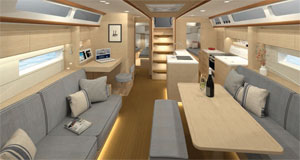 Above and below: The default saloon layout has L-shaped dinette seating and an island galley. The owner’s cabin has a king size bed facing aft
Above and below: The default saloon layout has L-shaped dinette seating and an island galley. The owner’s cabin has a king size bed facing aft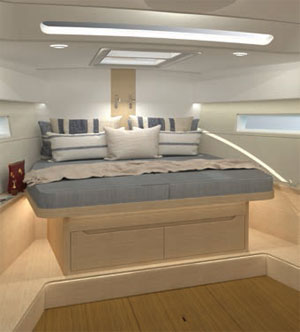
‘We’ve stopped talking about the navigation station and tend to refer to this area as the workstation as that is more what it represents,’ says Jeppesen. ‘This definition certainly made it easier when it came to designing the detail such as the fold-out stool.’
The galley area provides an interesting alternative layout with an island style as opposed to the conventional U-shaped configuration.
‘The main driver here was to provide a version that addressed the accessibility of the port saloon settee. With the longitudinal galley and island configuration you don’t have to work yourself around the U-shaped seating to get there as the seating is ‘L’ shaped,’ he continues.
One typically Scandinavian feature is the option to have two armchairs to starboard. And by this stage the final spec is all about personal preferences. The same is true for the layout of the two aft cabins which can be configured with either double or twin berths.
When it comes to interior finish, Khaya mahogany joinery work is the standard option with an alternative light oak finish for those that want an even brighter space below decks. What is less obvious is the amount of joinery such as table tops and floors that have a cored construction to help keep the overall weight down, yet without compromising on the quality of finish and robustness.
So, while it may not be so obvious below decks, the original focus on We’ve stopped talking about the navigation station and tend to refer to this area as the workstation remains true.
But there is another factor that Lagnéus believes is essential despite being harder to quantify.
‘We believe that all our boats have to pass two key tests. For us to have succeeded their owners have to love to sail them and love to look at them.’
And while looks may be subjective, given the amount of work that has gone into ensuring the best possible performance and handling from a team with a long track record in this field, the performance of the new Arcona flagship looks unlikely to be up for debate.
Click here for more information on Arcona »
We invite you to read on and find out for yourself why Seahorse is the most highly-rated source in the world for anyone who is serious about their racing.
To read on simply SIGN up NOW
Take advantage of our very best subscription offer or order a single copy of this issue of Seahorse.
Online at:
www.seahorse.co.uk/shop and use the code TECH20
Or for iPad simply download the Seahorse App at the iTunes store


